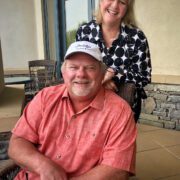The Porters area of Gainesville has an up-close look at the City of Gainesville’s downtown revitalization efforts and the University of Florida’s developing Innovation District.
To the southeast of Porters, you see Depot Park and the Cade Museum for Creativity and Invention. You could say the residents of Porters live in a prime location – a place where developers might want to build their next project.
“We really thought Porters was a neighborhood under an immediate threat from all sides, whether it was downtown or the Depot Avenue area or the Innovation District,” said Laura Dedenbach with the Florida Institute for Built Environment Resilience (FIBER) at the University of Florida.
Dedenbach partnered with Kathryn Frank in the UF Department of Urban and Regional Planning to study neighborhood preservation in the face of urban redevelopment. The goal was to craft a narrative for Porters created by its residents.
While such narratives are often used for visioning, Frank said this one is meant to empower residents “about how to come together as a neighborhood to advocate for their interests.”
The historically African-American neighborhood was established in 1884. Located near the railroad depot, it became home to porters who worked on the trains. Today, the community has approximately 1,000 residents, many from families that have lived there for generations.
Gigi Simmons is a city commissioner and Porters resident. She also served as a member of the steering committee that worked throughout the 15-month process.
“We were able to create our narrative and talk about who we really are, and what the community really truly means to the residents of the Porters Community,” Simmons said.
After assembling a steering committee from the neighborhood, building trust and having honest dialogue, a Porters’ story emerged. The narrative is composed of four themes: home, engaged and inclusive, resilient and opportunity.
“The Porters Community has a very rich history,” Simmons said. “This is what we came up with. This is our narrative.”
“They really focused on the good things their neighborhood provides and what they want to see for the future,” Dedenbach said.
“It was not trying to keep things the way they have been in the past,” Frank added. “It was accepting change, but wanting to be a part of it, and not fearing it.”
City Planner Andrew Persons thinks the time was right for Porters residents to create their own narrative.

“I don’t think we have any definite development plans in the works from private investors,” Persons said, “but it seems like now is a good time to understand the contours of the neighborhood and how the city can help ensure it is consistent with the residents’ desires for the future.”
City planners will continue to work with the steering committee and residents to help support the neighborhood’s narrative.
“That’s one of the reasons this has been an exciting idea for doing more fine-grain neighborhood work,” Persons said.
Frank’s and Dedenbach’s team not only wanted to help the Porters community, but to see if such an undertaking could be used in other neighborhoods.
“It is transferrable, and you don’t need to do everything the same,” Frank advised. “There should be some expertise with the people who are doing it – community development, urban planning and communications.”
She recommends the steering committee also have members who are connected to local government or in decision-making roles.
“There are some neighborhoods, like Porters, that don’t have a strong narrative and need help articulating that and communicating it,” Dedenbach said.
Persons agreed and listed the Pleasant Street, Fifth Avenue and Duval Heights neighborhoods as good areas to follow suit.
“A lot of great, long-established neighborhoods are in the core areas of the city,” Persons said, “and the deep dive that happened with Porters can be replicated there to set their identity and plot a course for the future.”


